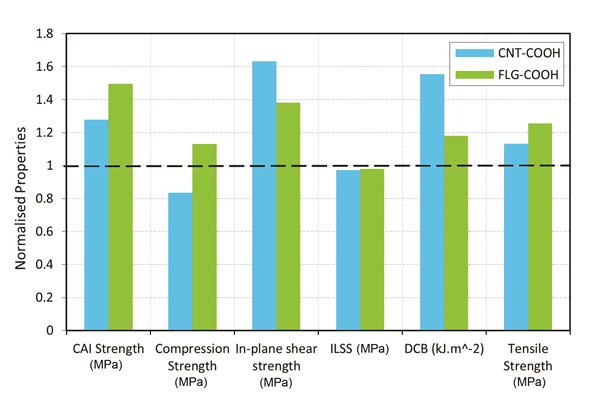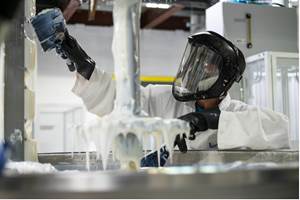Graphene-toughened composites
Are we getting closer to commercialized, and functional, nanotechnology?

Test results for composites made with carbon nanotube carboxylic acid (CNT-COOH) and few layered graphene carboxylic acid (FLG-COOH) show that adding nanomaterials increases compression strength 13 percent vs. normalized properties and boosts CAI by 50 percent. SOURCE: Cardiff University.
The School of Engineering at Cardiff University and graphene specialist company Haydale Ltd. (Carmarthenshire,U.K.) recently announced new research demonstrating significant improvements in mechanical performance of composites, including impact resistance, using plasma-treated graphene nanoplatelets (GNP).The research was undertaken by the Cardiff School of Engineering with additional funding from the European Community’s Seventh Framework program under the Clean Sky Joint Technology Initiative, aimed at greener aircraft design. The project included the Centro Italiano Richerche Aerospaziale (CIRA), and was managed by an integrated team from CIRA, Cardiff School of Engineering and Haydale.
The research investigated graphene nanoplatelet (GNP) and carbon nanotube (CNT) reinforcement technology. The results observed in this research show a 13 percent increase in compression strength and a 50 percent increase in compression after impact (CAI) performance (see graph above), indicating that fracture mode has been positively influenced, say researchers.
A resin infusion technique was employed to produce composites containing a small percentage of nanomaterials. Significantly, the nanomaterials were surface treated using Haydale’s trademarked low temperature, low energy HDPlas plasma process, which promotes homogenous dispersion and chemical bonding, without waste. The low pressure plasma process can treat both organic mined fine powder and other synthetically-produced nanomaterial powders, producing high quality few-layered graphenes and graphene nanoplatelets. Haydale says the process can functionalize with a range of chemical groups, where the amount of chemicals can be tailored to customer needs. Good dispersion improves the properties and performance of the host resin. The plasma process does not use wet chemistry, neither does it damage the material being processed. Energy requirements are low and the process is reportedly environmentally friendly.
Ray Gibbs, CEO of Haydale, says “These exceptional results underline the potential of Haydale’s tailored, plasma functionalization process in delivering a scalable technology for the production of superior composites. We believe that by working closely with the Cardiff School of Engineering, our combined resources and expertise can significantly accelerate graphene optimization.” Professor Sam Evans from the School of Engineering, Cardiff University, agrees, saying “This research represented a fantastic opportunity for the team at Cardiff to work with graphene materials and technology. Graphene technology has enormous potential for improving the performance of aircraft materials. These initial results suggest that there may be the potential for big weight reductions in aircraft and many other applications, which is very promising.”
Let’s hope that the research comes to fruition. There are many commercialization challenges in moving beyond the lab, and costs of these GNPs has traditionally been very high, as noted by Lux Research senior analyst Ross Kozarsky in the 2013 HPC article, "Graphene: Ready for prime time?". For nanotechnology to benefit composite fabricators, the costs must come down.
One promising nanotechnology product is offered by OCSiAl (U.S. offices in Palo Alto, Calif. and Columbus, Ohio), an exhibitor at the recent CAMX conference and exhibition (Oct. 13-16, Orlando, Fla.). The company can produce single-wall carbon nanotubes (SWCNTs), trademarked Tuball, promoted as a “universal nanomodifier” additive for many types of materials, at a mass industrial scale in a reportedly continuous process. The company offers the Tuball product at the incredibly low price of $2 per gram, according to its Web site. Others are also bringing less expensive products to the market as reported in the September issue of Nanotech Magazine. Perhaps greater adoption of nanotechnology forms for better-performing composites will soon be a reality.
Related Content
XlynX’s PlastiLynx PXN crosslinking primer enhances polymer adhesion
PFAS-free diazirine primer makes surfaces receptive to all manner of adhesives, including epoxies and polyurethanes, outperforming alternative options by 150-350%.
Read MoreScott Bader ATC begins Crestabond MMA structural adhesive production
Scott Bader’s Drummondville, Canada, facility has begun manufacturing and supplying composites-applicable adhesives to its North American customers.
Read MoreMaterials & Processes: Fabrication methods
There are numerous methods for fabricating composite components. Selection of a method for a particular part, therefore, will depend on the materials, the part design and end-use or application. Here's a guide to selection.
Read MoreScott Bader partners with Elixir for Crestabond distribution in India
Crestabond MMA structural adhesives range will continue to drive advanced composites growth in India, in addition to Scott Bader’s global expertise and local technical support.
Read MoreRead Next
CW’s 2024 Top Shops survey offers new approach to benchmarking
Respondents that complete the survey by April 30, 2024, have the chance to be recognized as an honoree.
Read MoreComposites end markets: Energy (2024)
Composites are used widely in oil/gas, wind and other renewable energy applications. Despite market challenges, growth potential and innovation for composites continue.
Read MoreFrom the CW Archives: The tale of the thermoplastic cryotank
In 2006, guest columnist Bob Hartunian related the story of his efforts two decades prior, while at McDonnell Douglas, to develop a thermoplastic composite crytank for hydrogen storage. He learned a lot of lessons.
Read More
















.jpg;maxWidth=300;quality=90)









